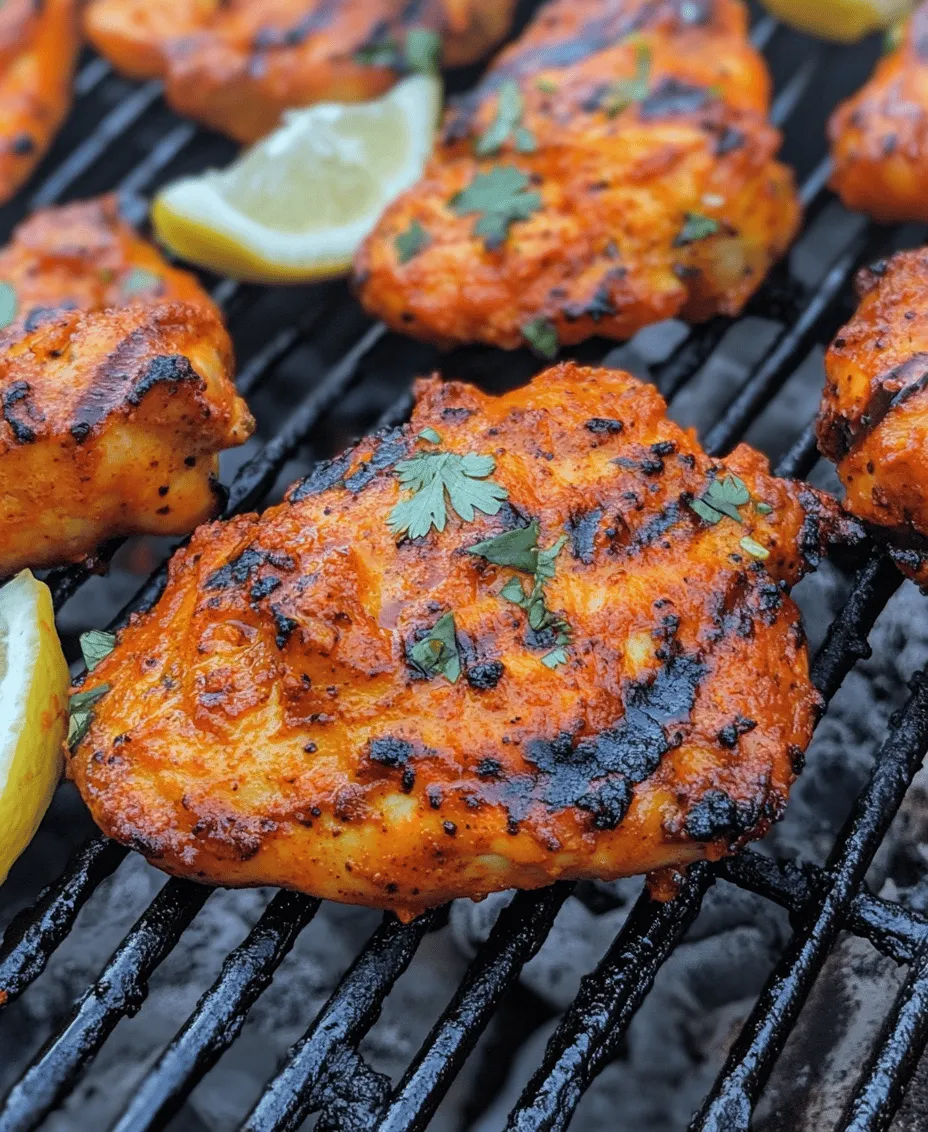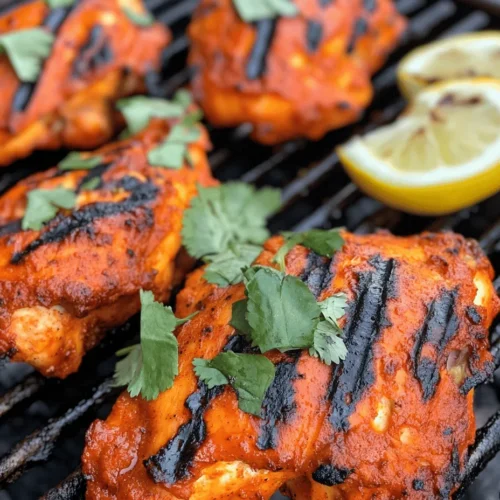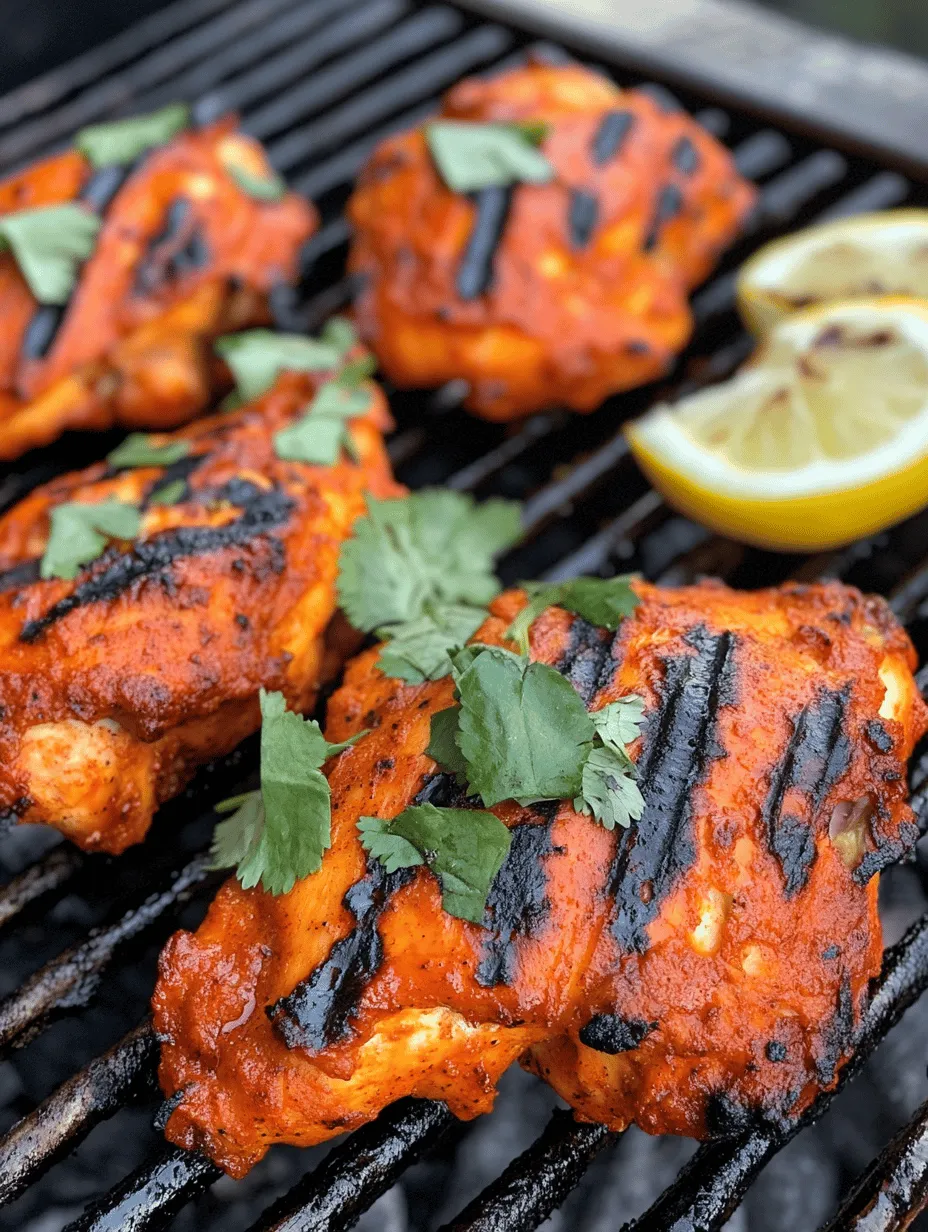Introduction
Tandoori chicken is a beloved dish that has gained international fame for its bold flavors and vibrant colors. Originating from India, this dish is deeply rooted in the culinary traditions of the Indian subcontinent and is often associated with festive celebrations and communal gatherings. The name “tandoori” comes from the traditional clay oven known as a “tandoor,” where the chicken is typically cooked at high temperatures, giving it a distinct smoky flavor and charred exterior.
The appeal of grilled Tandoori chicken lies not only in its mesmerizing aroma and tantalizing taste but also in its health benefits. Made with lean cuts of chicken marinated in a mixture of yogurt and spices, this dish is lower in calories compared to many fried alternatives, making it an excellent choice for health-conscious diners. Additionally, the grilling technique allows excess fat to drip away, resulting in a lean and flavorful meal.
One of the best aspects of grilled Tandoori chicken is its versatility. Whether you’re hosting a casual get-together with friends, planning a family dinner, or preparing for a festive occasion, this dish fits seamlessly into any culinary setting. The vibrant colors and aromatic spices not only make it a feast for the palate but also a feast for the eyes, sure to impress your guests.
Understanding Tandoori Cooking
Traditional Tandoori cooking methods involve marinating meat in a blend of spices and yogurt, then cooking it in a tandoor, which reaches temperatures exceeding 800°F (427°C). This cooking style infuses the chicken with a rich flavor profile and ensures it remains moist and tender. While many home cooks may not have access to a tandoor, grilling is a fantastic alternative that can replicate some of the signature characteristics of this cooking method.
Grilling Tandoori chicken allows you to achieve that same smoky flavor and crispy texture. The high heat from the grill mimics the intense heat of the tandoor, helping to caramelize the spices on the surface of the meat while keeping the inside juicy and succulent.
At the heart of Tandoori chicken is its unique blend of spices, known as Tandoori masala. This spice mix typically includes ingredients like cumin, coriander, turmeric, and cayenne pepper, each contributing not only to the flavor but also to various health benefits. For instance, cumin is known for its digestive properties, while turmeric contains curcumin, a powerful antioxidant with anti-inflammatory effects.
Yogurt plays a crucial role in the marination process. It acts as a tenderizer due to its lactic acid content, which breaks down the proteins in the chicken, resulting in a softer texture. Additionally, yogurt helps the spices adhere to the chicken, ensuring that every bite is packed with flavor.
Ingredients Breakdown
To create the perfect grilled Tandoori chicken, you’ll need a selection of key ingredients that work together to build flavor and texture. Let’s break down each ingredient and its significance:
1. Bone-in Chicken Thighs: While Tandoori chicken can be made with a variety of chicken cuts, bone-in thighs are preferred for their flavor and juiciness. The bone helps to retain moisture during cooking, ensuring that the meat remains tender and flavorful.
2. Plain Yogurt: Opting for plain, unsweetened yogurt is essential for this recipe. It not only tenderizes the chicken but also adds creaminess to the marinade, which helps to balance the spices. Yogurt also enhances the overall flavor profile, making the chicken more aromatic and delicious.
3. Fresh Lemon Juice: The acidity from fresh lemon juice is crucial for brightening the flavors of the marinade. It adds a zesty kick that complements the spices and enriches the overall taste of the dish.
4. Tandoori Masala: You can either purchase pre-made Tandoori masala from the store or make your own at home. Store-bought options are convenient and varied, but making your own allows you to customize the spice levels according to your taste preferences. A homemade blend typically includes a mix of spices such as paprika, cumin, coriander, ginger, and garlic.
5. Spices: In addition to Tandoori masala, you can enhance the flavor of your chicken with individual spices like:
– Cumin: Provides a warm, earthy flavor.
– Coriander: Adds a hint of citrus and sweetness.
– Paprika: Offers a mild sweetness and vibrant color.
– Turmeric: Contributes a golden hue and anti-inflammatory properties.
– Cayenne Pepper: Adds heat and depth to the marinade.
6. Fresh Cilantro and Lemon Wedges: These ingredients are not just for garnish; they enhance the presentation of the dish while providing additional flavor. Fresh cilantro adds a burst of freshness, while lemon wedges allow diners to squeeze extra acidity over their servings, elevating the dish even further.
Step-by-Step Guide to Preparing Grilled Tandoori Chicken
Marination Process
The marination process is the heart and soul of making delicious grilled Tandoori chicken. It is essential for flavor development and ensuring the chicken is tender and juicy. Here’s how to marinate your chicken effectively:
1. Prepare the Marinade: In a large mixing bowl, combine plain yogurt, fresh lemon juice, Tandoori masala, and your choice of spices. Whisk the mixture until it is well blended, creating a smooth and flavorful marinade.
2. Add the Chicken: Place the bone-in chicken thighs into the bowl with the marinade. Ensure that each piece is fully coated. It’s best to use your hands for this step, as it allows you to massage the marinade into the crevices of the chicken, ensuring even flavor distribution.
3. Marinating Time: For optimal results, allow the chicken to marinate for at least one to two hours. However, if you have the time, overnight marination is highly recommended. This extended period allows the flavors to penetrate deeply into the meat, resulting in a more flavorful dish.
4. Storage Tips: If marinating overnight, cover the bowl with plastic wrap or transfer the chicken and marinade to a resealable plastic bag. This prevents any unwanted odors from affecting the chicken while it marinates in the refrigerator.
5. Prepping for the Grill: Once the marination period is complete, remove the chicken from the refrigerator. Allow it to sit at room temperature for about 30 minutes before grilling. This step helps to ensure even cooking.
6. Grill Preparation: Preheat your grill to medium-high heat. If you’re using a charcoal grill, make sure the coals are hot and ashy. For a gas grill, set it to high and allow it to preheat for about 10-15 minutes.
7. Tips for Even Coating: If any excess marinade is present on the chicken, gently scrape it off before placing the chicken on the grill. This helps prevent flare-ups and burning while ensuring the chicken cooks evenly.
Grilled Tandoori chicken is not just a dish; it’s an experience that brings together the essence of Indian cuisine with its robust flavors and aromatic spices. The process of marination, grilling, and serving creates a delightful journey that will leave your taste buds craving more. As you prepare this dish, you will not only impress your guests but also enjoy the satisfaction of creating a culinary masterpiece that is both healthy and delicious.

Preparing the grill properly is crucial for achieving that perfect grilled Tandoori Chicken. Whether you’re using a gas or charcoal grill, understanding the nuances of each will help you master the grilling process.
Preparing the Grill
How to Preheat Different Types of Grills
1. Gas Grill: Start by turning on the gas supply and igniting the burners. Set the grill to medium-high heat. Close the lid and allow it to preheat for about 10-15 minutes until the internal temperature reaches around 400°F to 450°F (200°C to 230°C). This high heat is essential for searing the chicken and locking in the flavors.
2. Charcoal Grill: Begin by lighting your charcoal using a chimney starter or lighter fluid. Once the coals are covered with a white-gray ash, spread them evenly across the grill. If you’re aiming for direct heat, arrange the coals in a single layer; for indirect heat, pile the coals on one side. Close the lid and let it preheat for about 10 minutes, ensuring the grill temperature reaches around 400°F to 450°F (200°C to 230°C).
Tips for Achieving the Perfect Grilling Temperature
– Use a grill thermometer: This ensures your grill is at the desired temperature before you start cooking.
– Adjust vents: For charcoal grills, open vents allow more oxygen, increasing the heat, while closing them cools it down.
– Keep the grill clean: A clean grill not only prevents sticking but also helps maintain consistent temperatures.
Grilling Techniques
Detailed Instructions on Grilling the Chicken
1. Placement: Once the grill is preheated, place the marinated chicken pieces on the grill over direct heat for the initial searing. Ensure there’s enough space between each piece to allow the heat to circulate.
2. Cooking Times and Temperature Checks: Grill the chicken for about 5-7 minutes on one side without moving it around too much. This helps develop a nice char. After that, flip the chicken and grill the other side for another 5-7 minutes. Use a meat thermometer to check for doneness. The internal temperature should reach 165°F (74°C).
3. Signs of Doneness: Look for the chicken to be opaque and firm, with juices running clear. Additionally, the exterior should have a beautiful golden-brown char. If you prefer a deeper char, you can move the chicken to a cooler part of the grill after searing and close the lid to allow it to cook through without burning.
Serving Suggestions
Ideas for Pairing Grilled Tandoori Chicken
Grilled Tandoori Chicken can be served in various delightful ways, enhancing the overall dining experience.
– Traditional Sides: Serve the chicken alongside fluffy naan bread, fragrant basmati rice, or a refreshing salad. The naan is perfect for scooping up the chicken, while basmati rice complements the spices beautifully.
– Suggestions for Sauces or Dips: Accompany the chicken with cooling sauces like mint chutney or yogurt sauce. These dips not only enhance the flavor but also balance the heat from the spices.
– Creative Ways to Present the Dish: For gatherings or special occasions, consider presenting the chicken on a large platter, garnished with fresh cilantro, lemon wedges, and onion rings. You can also skewer the chicken pieces on sticks for an appealing, easy-to-eat presentation.
Health Benefits of Grilled Tandoori Chicken
Grilled Tandoori Chicken is not only delicious but also packed with nutritional benefits.
Nutritional Overview: The primary ingredients—chicken, yogurt, and spices—are rich in protein, calcium, and essential vitamins. Yogurt, a key ingredient in the marinade, is a probiotic that aids digestion. The spices used, like turmeric and cumin, are known for their anti-inflammatory properties.
Comparison to Other Cooking Methods: Grilling is a healthier cooking method compared to frying, as it allows excess fat to drip away, resulting in lower calorie content. Grilled meats also retain more nutrients than those cooked at high temperatures in oil.
Health-Conscious Modifications: For those looking to reduce calories, using low-fat yogurt instead of full-fat can provide a similar taste with fewer calories. Additionally, opting for skinless chicken cuts can further decrease fat content without sacrificing flavor.
Cultural Variations and Personal Touches
Tandoori Chicken has a rich history, with variations across different regions in India and beyond.
Exploration of Regional Variations: In Punjab, you’ll find Tandoori Chicken marinated with a variety of spices and often served with a rich, creamy sauce. In contrast, the Hyderabad version is known for its fiery spice levels and is sometimes cooked with saffron for a unique twist.
Ingredient Substitutions or Modifications: For those following vegetarian diets, consider substituting chicken with paneer or firm tofu, marinated in the same Tandoori spices. These alternatives absorb the flavor beautifully and provide a satisfying texture.
Conclusion
Grilled Tandoori Chicken is not just a dish; it’s an experience—one that celebrates vibrant flavors and cultural traditions. Its versatility allows for endless variations, making it a staple in both casual family dinners and festive gatherings.
Encouraging readers to embrace the cooking process, this dish invites experimentation with spices and sides, ensuring that each person can put their own twist on it. As you explore the flavors and techniques of Tandoori Chicken, remember that the joy of cooking comes from the journey, not just the destination. Make this dish a regular part of your culinary repertoire, and enjoy the delightful taste of grilled perfection.



